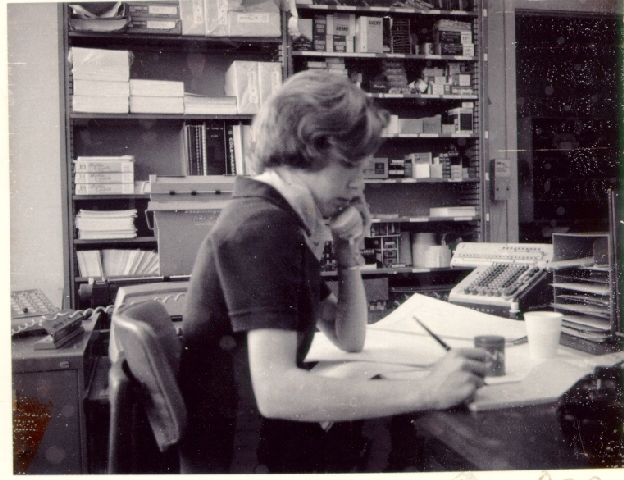 |
 |
 |

|

|
 |
| click for larger images [taken by Hector Garcia-Molina] |

| 
| 
| 
|  |
| large Monroe | large Friden | large Marchant | large Marchant keys | large Marchant carriage |
Calculator display
Monroe, Friden, Marchant
Monroe Decimal Calculator, ca.1930.
(leftmost in display)
Inventor: Frank Stephen Baldwin 1839-1925.
Baldwin patented a pinwheel device that enabled carries in a compact device. In 1900 he invented a method that allowed digits to be entered by a single stroke. In 1912 Baldwin joined Randolph Monroe and founded the Monroe Calculating Machine Company, in New Jersey. The Monroe Company is now located in Levittown PA and still sells calculators, although from 1953 to the early 1960's it also made a series of small computers: MonRobots (I to XI), as part of Litton Industries.
This 10-key calculator provided accurate manual computation. Its operator was called a computor. Each complete forward turn of the large crank on the right will add the value set into the 8 x 10 keys into the bottom register of the carriage. The main register on the carriage shows the result. The smaller register above it counts the turns. Subtraction is achieved by turning the crank in reverse. To multiply by more than one digit the Repeat button is pressed and the crank turned as often as needed for the low-order digit. Then the carriage is moved to the right with the handle in front, so the next digit of the factor can be cranked in. The crank on the carriage is for resetting result and counter registers. Division is performed by subtracting the divisor left to right.
A predecessor handheld device, the Comptator, is shown on the second floor.
Courtesy of Gio Wiederhold.
Marchant Electric Calculator, ca. 1950.
(rightmost in display)
Marchant Calculator Comp. , Oakland CA.
This calculator was used by Prof. George Forsythe, founding chairman of the Stanford Computer Science department.
This calculator replaced the human power required in earlier machines
(see the Monroe calculator) with an electric motor, a single on/off
relay and a number of mechanical clutches. Selection one of 10 keys on the
right side determines the number of turns for multiplication.
After one digit was processed the carriage would shift left or right
(controlled by a double key next to the multipliers) and the next
(to the right or left) multiplier digit could be entered.
Division was automated by entering the divisor in the keys and continuing
subtraction until the the dividend was fully reduced*. The carriage
would then shift left and division continued.
The Marchant Company started in Oakland, California, before 1911 and
merged with Smith Corona in the 1950s.
* For each digit subtraction for division actually continued until the sign changed, then subtraction stopped, the divisor was added back in once, and then the carriage was shifted to continue to generate the next digit of the quotient.
A picture of an early electrical Marchant is on the web.Courtesy of the Estate of George and Sandra Forsythe.
Friden Automatic Calculator, model SW, 1956
(center of display)
Friden, Inc, San Leandro CA.
The Friden calculator machine further automated calculation by allowing a multiple digit factor to be entered in the small panel on the left of the main keyboard. Multiplication continues right to left, while the carriage shifts left, until all digits have been consumed. The result is appears on top.
A side panel and the top cover have been removed to provide an impression of the complexity of mechanical computation. Friden even produced a model which could take square roots automatically. This type of calculator represents the end-of-the-line for mechnical digital calculation. Friden operated in San Leandro until the 1970's making early electronic accounting machimes there and in Nijmegen, Holland.
Courtesy of Professor Robert Floyd
A comprehensive description of calculators is found at dotpoint.com. More information and pictures are available on a wide range of calculators is found at the HP calculator museum site.
Such calculators remained in use for a long-time. Even in the modern environment of the Stanford Artificial Intelligence Laboratory we find a later model Monroe Calculator in use in 1968.
 |
SAIL administrator, Queenie Bauer, with Monroe Calculator (~1968)
Other items typical for an office in those days are the multi-button phone on the far left (no number memory, no music while on hold), the electric typewriter behind Queenie (no network) with a sheet-holder above it to hold a source for copying text (no drag-and-drop), and the small bottle of white-out fluid to make corrections in front of the calculator (no word-processing software).
Photo courtesy of Bruce Baumgart.
 |
 |
 |

|

|